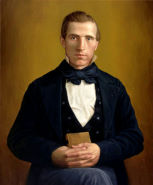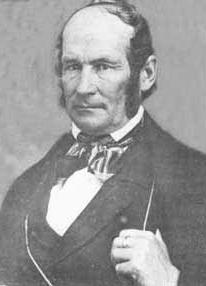By Randy Jordan
Dear Editor,
Salt Lake Tribune:
I read, open-jawed, Hilary Groutage Smith's article in the
Saturday, August 10th 2002, Tribune concerning a speech
on 19th-century Mormon polygamy delivered at the recent
FAIR convention by BYU assistant professor of history Kathryn
Daynes.
The reasons Ms.
Daynes offers for the origins and purposes of 19th-century
Mormon polygamy (as reported by Ms. Smith) do not comport
in the least with known and accepted historical facts. It
would require many pages of documentation to attempt to
correct the misinformation with which Ms. Daynes has filled
her audiences' minds, but I'd like to note a few items in
brief in rebuttal to her remarks, and hope that you will
consider publishing my comments.
Ms. Daynes essentially
asserts that the Mormons practiced polygamy in order to
provide husbands and fathers for widows and children of
Mormon men who had died because of "religious persecution"
or on the trek westward, or because of an alleged "shortage
of men" in those days. Nothing could be further from
the truth.
To begin with, the first rumblings of polygamy in Mormonism
came in 1831, when Joseph Smith counseled a group of already-married
Mormon elders:
 "For
it is my will, that in time, ye should take unto you wives
of the Lamanites and Nephites, that their posterity may
become white, delightsome and Just, for even now their
females are more virtuous than the gentiles." "For
it is my will, that in time, ye should take unto you wives
of the Lamanites and Nephites, that their posterity may
become white, delightsome and Just, for even now their
females are more virtuous than the gentiles."
- Prophet Joseph Smith, The
Joseph Smith Revelations Text and Commentary, p. 374-37.
Joseph Smith
hoped that if Mormon elders "married" Native-American
women, then the Mormons could legally settle on Native-American
lands in Kansas, which was then off-limits to white settlers.
Federal agents quickly told the Mormons to stay on the eastern
side of the Missouri River, and to leave the Native-Americans
alone.
As these events
occurred long before there were any Mormon men killed by
"persecution," and Smith's "revelation"
dealt only with taking Native-American women to wife, Ms.
Daynes' "Mormon widows needed husbands" angle
is without merit.
Secondly, the
first documented "plural wife" in Mormon history
was no widow, but rather a 16-year-old single girl named
Fannie Alger, who was Emma Smith's housemaid. Several of
Joseph Smith's intimate followers asserted that Smith "married"
Alger around 1833, in Kirtland, Ohio. That relationship
caused quite a scandal in Kirtland, wherein Smith's subordinates
Oliver Cowdery and Warren Parrish attempted to bring Smith
to a church trial on charges of adultery. Smith had a loyalist,
Levi Hancock, spirit Miss Alger out of town to prevent her
from testifying to the relationship. Miss Alger later civilly
married one Solomon Custer in Indiana, and apparently had
nothing more to do with Mormonism.
In the 1890's,
assistant LDS Church historian Andrew Jenson listed Miss
Alger as Joseph Smith's first-ever "plural wife."
As Miss Alger was an unmarried teenager at the time of her
relationship with Smith, and in fact was very marriageable
in the eyes of Solomon Custer, Smith had no need to "marry"
her to provide for her.
Smith's second documented "plural marriage" (in
1838) was to Lucinda Morgan Harris, who was currently married
to George Washington Harris, a high councilor in the Far
West, Missouri, Mormon stake. As Mrs. Harris had a currently-living
husband, Smith obviously didn't marry her because she was
a widow or because of "persecution."
In fact, as
LDS historian Todd Compton shows in his excellent book "In
Sacred Loneliness: The Plural Wives of Joseph Smith,"
of Smith's 33 well-documented "plural wives,"
at least eleven of them had legal husbands at the time of
their "sealing" to Smith. And, contrary to popular
myth, none of those women were estranged from their legal
husbands, so Smith didn't take them into his household to
provide for them.
Among the currently-married
women Smith "plural married" were:
- Nancy
Marinda Hyde (the wife of Orson Hyde, whom Smith
had sent on a mission to Palestine)
- Zina
Huntington Jacobs (future general Relief Society
President and then-wife of Henry Jacobs)
- Mary
Rollins Lightner (wife of non-Mormon Adam Lightner---the
same woman who, as a young girl, "saved" the
manuscript pages of the 'Book of Commandments' from a
Missouri mob in 1833.)
Among Joseph
Smith's other "plural wives" were the two daughters
of the late Edward Partridge and the two daughters of the
deceased Edward Lawrence. As those girls were young, single,
and marriageable, Smith certainly didn't need to marry them
to provide them, or any other of his currently-married "plural
wives," with an upkeep.
In fact, since
there is much
evidence that most of those womens' relationships with Joseph
Smith were sexual---and little evidence that Smith provided
for their maintenance---the "women needed husbands
to take care of them" is again invalidated. The "women
needed husbands" angle seems to be the exception in
Mormon polygamy, rather than the rule.
After Joseph
Smith's death, some of his successors maintained his polyandrous
practice: Brigham Young took Zina Jacobs for himself, telling
her husband Henry that he "would have to go and get
another" wife. Zina bore a child by Young on April
3, 1850.
Brigham Young
explained that such appropriations of already-married women
were part of Joseph Smith's theology, which stated that
a Mormon man who held a "higher power and authority
than her husband" had the privilege of making "her
his wife...he can do so without a bill of divorcement."
Young's counselor,
Apostle Jedediah M. Grant, also referred to this practice
in an 1854
sermon by stating:
"now suppose
Joseph [Smith] should come and say he wanted your wife,
what would you say to that?.....[I would say] here she
is, and there are plenty more." (JD
2: 13-14)
As the polygamy
practice increased in Utah from the 1850's-'80s, several
instances occurred where "higher-ranking" Mormon
men appropriated the wives of subordinates; and there were
many more occasions where higher-ranking priesthood holders
broke the hearts of young men by taking their intended brides
as their own plural wives. At that time, Mormon theology
held that the more "plural wives" a man had, the
greater his "kingdom" would be in the afterlife.
Therefore, it was appropriate that the highest-ranking leaders
could attract the greatest number of "plural wives"
who could "ride his coattails" into his "celestial
kingdom." This practice was so prevalent that many
Mormon women had themselves "sealed by proxy"
to Smith, Young, or other high leaders, even though they
had no earthly relationship with them.
Concerning Ms.
Daynes' assertion about a shortage of Mormon men being a
justification for polygamy, LDS Apostle John A. Widtsoe
discredited that myth nearly a century ago, stating:
"Members
of the Church unfamiliar with its history, and many non-members,
have set up fallacious reasons for the origin of this
system of marriage among the Latter-Day Saints. The most
common of these conjectures is that the Church, through
plural marriage, sought to provide husbands for its large
surplus of female members. The implied assumption in this
theory, that there have been more female than male members
in the Church, is not supported by existing evidence.
On the contrary, there seem always to have been more males
than females in the Church....The United States Census
records from 1850 to 1940, and all available Church records,
uniformly show a preponderance of males in Utah, and in
the Church." ("Evidences
and Reconciliations," p. 391.)
Ms. Daynes' remark
that the Martin/Willey handcart company tragedies "created
more widows" is also specious, considering that those
pioneers traveled as families, and wives died right along
with their husbands. Many high-ranking Mormon leaders had
numerous "plural wives." Brigham Young had more
than 50, and Heber C. Kimball more than 40. Several of their
favored subordinates also had many, as exemplified by Bishop
John D. Lee's 18.
In light of
that, contrary to Ms. Daynes' assertions about there being
a "shortage of men," the polygamy practice actually
created a shortage of marriageable women.
In fact, the leaders' "hoarding" of wives contributed
to the actual decline in new polygamous unions even before
the 1890 Manifesto, because many young, marriageable Mormon
men were finding that girls whom they might have courted
were being snapped up by higher-ranking leaders. The church
even counseled missionaries leaving for Europe not to marry
all the women they converted, but to bring back some of
the ladies for the leaders.
 "Brethren,
I want you to understand that it is not to be as it has
been heretofore. The brother missionaries have been in
the habit of picking out the prettiest women for themselves
before they get here, and bringing on the ugly ones for
us; hereafter you have to bring them all here before taking
any of them, and let us all have a fair shake." "Brethren,
I want you to understand that it is not to be as it has
been heretofore. The brother missionaries have been in
the habit of picking out the prettiest women for themselves
before they get here, and bringing on the ugly ones for
us; hereafter you have to bring them all here before taking
any of them, and let us all have a fair shake."
- Apostle Heber C. Kimball, The Lion of the Lord,
New York, 1969, pp.129-30.
and again...
"I say
to those who are elected to go on missions, remember they
are not your sheep: they belong to Him that sends you.
Then do not make a choice of any of those sheep; do not
make selections before they are brought home and put into
the fold. You under stand that. Amen"
- Apostle Heber C. Kimball, Journal of Discourses,
vol. 6, p.256.
That further
demonstrates that the "shortage of men" justification
is fallacious.
One further note
- Joseph Smith's 1843 "revelation on celestial marriage"
which is still canonized Mormon scripture as Doctrine and
Covenants Section 132, states that the purposes of "plural
marriage" was to "multiply and replenish the earth"
(D&C 132:63). Nowhere in the revelation does it mention
taking care of widows.
Seeing as how
a woman can only become pregnant by one fertile man at a
time, that means that the "multiply and replenish"
aspect of "plural marriage" fails for lack of
logic. To increase population, a Mormon man wouldn't need
numerous "plural wives" with which to reproduce
- one fertile man being mated with one fertile woman would
produce as many, if not more children over time than would
one polygamous man with numerous wives.
Ms. Daynes cited her research of 269 Mormon pioneer women,
one-third of whose fathers were "dead or not in Utah,"
as being another justification for polygamy. I fail to grasp
Ms. Daynes' logic here, as women who have no fathers don't
need fathers; they need husbands. And seeing as how most
Mormon men had sex with, and bore children by, their "plural
wives," including teenage ones, it's rather obvious
that those marriages were not intended to replace a lost
father.
Someone once
said that "Mormons' knowledge of their own history
is a mile wide and an inch deep." It's disappointing
to see that that quip extends to someone who is supposed
to be a professor of history. If Ms. Daynes' remarks are
an example of the "Mormon history" that the LDS
Church wishes to be dispensed, then I'll opine that as time
passes, future Mormons will be completely ignorant of the
true facts of their own history.
Randy Jordan
More
on Mormon Polygamy
Introduction
| LDS History | LDS
Leaders | Mormon Temples
Mormon Sexuality | Commentaries
| Church Parables | Useful
Lists
Recovery | Related
Links |